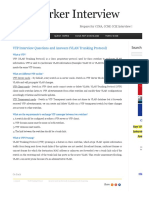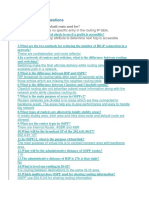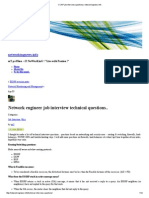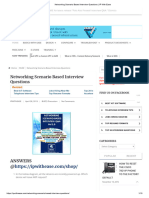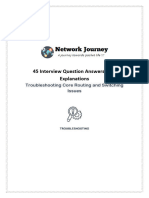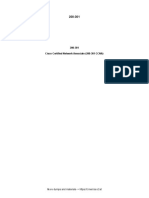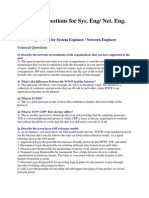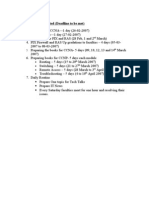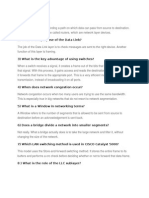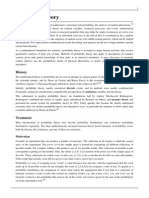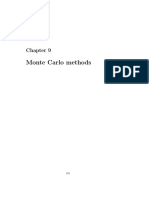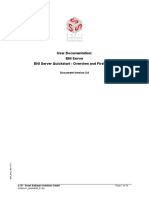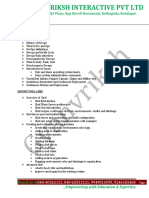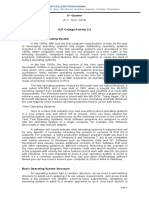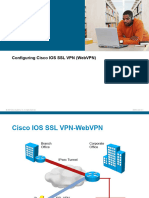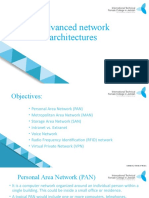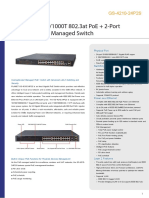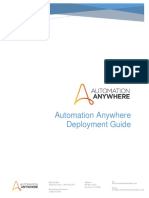OSPF
1 Describe OSPF in your own words
2 OSPF areas, the purpose of having each of them
3 Types of OSPF S!, the purpose of each S! type
" #hat e$act S! type you can see in different areas
% &ow OSPF estab'ishes neighboor re'ation, what the stages are
( )f OSPF router is stuc*ed in each stage what the prob'em is and how to
troub'eshoot it
+ OSPF hierarchy in the sing'e or mu'ti areas ,oo' OSPF behavior in broadcast and
nonbroadcast
- Draw the diagram of typica' OSPF networ* and e$p'ain genera''y how it wor*s,
D., /D., e'ection, !S/., !/., route redistribution and summari0ation
STP
1 &ow it wor*s and the purpose
2 Diff types 1SSTP, 2STP, .STP3 ,isco 4 P5ST6P5ST7
3 root e'ection
" Diff port stages and timing for convergence
% Draw the typica' diagram and e$p'ain how diff types of STP wor*
( #hat ports are b'oc*ing or forwarding
+ &ow it wor*s if there are topo'ogy changes
ACLs
1 #hat are they
2 Diff types
3 #rite an e$amp'e if you want to a''ow and to deny8
" #e''4*nown port numbers 1D9S 4 %3 and etc83
QOS
1 #hat is that
2 #hat is the diff b6w 2 and 3 :oS
3 &ow it wor*s
9etwor*;
1 Draw the typica' networ* diagram you have to dea' with
2 e$p'ain how it wor*s
3 #hat part of it you are responsib'e
" firewa'', what is that, how it wor*s, how it is diff from !,s
% #hat prob'ems with the networ* you had had and how you so'ved it
( #hat are the ways to troub'eshoot the networ*, techni<ues, commands
+ networ* security, ways to achieve it
Switching:
1 5!9s
2 STP
3 &ow a 2 switch wor*s with broadcast, unicast, mu'ticast, *nown6un*nown
traffic
" 5..P, =/P
% port monitoring and mirroring
( 3 switch, how it wor*s
( P)2 sparse and dense modes
Networking Basics
1 ,an you define protoco'>
2 ,an you e$p'ain the concept of OS) 'ayer>
3 ,an you e$p'ain the different 'ayers in OS) mode'>
" ,an you e$p'ain !pp'ication 'ayer in OS) mode'>
% ,an you e$p'ain Presentation 'ayer in OS) mode'>
( )s it compu'sory that compression, encryption and trans'ation
+ functions wi'' be used during communication>
- ,an you e$p'ain Session 'ayer in OS) mode'>
? #hat@s the concept of Simp'e$, &a'f Dup'e$ and Fu'' Dup'e$ dia'ogs>
1A #hat are the different types of dia'ogs in Session 'ayer>
11 ,an you e$p'ain Transport 'ayer in OS) mode'>
12 ,an you e$p'ain the concept of ,ongestion>
13 ,an you e$p'ain 9etwor* ayer>
1" ,an you e$p'ain Data 'in* ayer>
1% ,an you e$p'ain the Physica' 'ayer>
1( ,an you e$p'ain what an )P address is>
1+ &ow to convert Decima' to /inary>
1- &ow many )P addresses can come in )P5">
1? ,an you e$p'ain the concept of Bnicast )P address>
2A ,an you e$p'ain the concept of )P mu'ticasting or mu'ticast )P
address>
21 &ow many different types of subnet c'assfu' networ*s are present>
22 #hat are the )P address ranges for pub'ic and private )P address>
23 #hy do we need c'ass and how many different types of c'ass e$ists>
2" &ow are the )P addresses distributed between different c'asses>
2% ,an you e$p'ain what is c'assfu' )P addressing>
2( ,an you e$p'ain the concept of subnetting>
2+ #hat are the advantages of using subneting>
2- )f the host has the subnet )D why do we need a subnet mas*>
2? &ow is networ* address ca'cu'ated from the subnet>
3A #hat is the advantage of using c'ass'ess addressing over c'assfu'
addressing scheme>
31 ,an you e$p'ain the concept of ,)D.>
32 Twist ;4 ,an you e$p'ain superneting >
33 ,an you e$p'ain concept of custom subneting>
3" #hat is the imp'ication of increasing and decreasing subnet /its>
3% #hy do we need to subtract two from number of hosts>
3( ,an you e$p'ain the concept of 5S2>
,an you e$p'ain )P protoco'>
Routers
1 ,an you e$p'ain the concept of DPB, Segments, Datagram, Frame and
pac*et>
2 #hat is )P datagram fragmentation and 2TB>
3 ,an you e$p'ain in detai' with e$amp'e how data fragmentation wor*s>
" arger the )P datagram 'ess the overhead, is it true or fa'se>
% #hat is the minimum si0e of 2TB bytes>
( ,an you e$p'ain how optima' 2TB si0e is ca'cu'ated>
+ &ow does the )P message fina''y reassemb'e>
- ,an you e$p'ain the concept of .epeaters, &ubs, /ridges, Switches and
.outers>
? On what 'ayers do router , switched , bridges and hubs operate >
1A ,an you e$p'ain the concept of ayer 3 switches>
11 what are ,SB, DSB and TSB>
12 what are the basic components of the router>
13 ,an you e$p'ain the #!9 and !9 )nterface in .outers>
1" #hat are D/41%, D/4(A and .C4"% in ,)S,O routers>
1% ,an you e$p'ain the concept of TT>
1( #hat is the concept of ),2P pac*ets>
1+ #hich operating system does ,)S,O have>
1- ,an you e$p'ain the concept of 9!T>
1? &ow is 9!T imp'emented>
2A ,an you e$p'ain how actua''y 9!T wor*s>
21 why does co''ision occur in &B/S and repeaters>
22 ,an you e$p'ain the concept of ,o''ision domain>
23 #hat is the concept of routing tab'es>
2" what is the use of route print>
2% ,an you e$p'ain how in detai' how routing tab'e 'oo*s 'i*e>
2( &ow can you see route tab'es on the router>
2+ ,an you e$p'ain the concept of static and dynamic routing>
2- #hen to use Static routes and dynamic routes>
2? &ow do you configure static routes on a router>
3A ,an you e$p'ain static defau't routes>
31 #hat is the advantage of using Static defau't routes>
32 #hy do wor*stations have route tab'es>
33 #hat is the concept of gateway of 'ast resort>
3" ,an you e$p'ain the concept of routing protoco'>
3% #hat activities does routing protoco' perform>
3( #hat metrics are used by routing protoco's to determine the best
path>
3+ ,an you e$p'ain what is interior and e$terior routing protoco's>
3- ,an you e$p'ain the concept of intradomain and interdomain routing
protoco's>
3? ,an you e$p'ain the concept of internetwor* and intranetwor* routing
protoco's>
"A #hich method does routing protoco' use to determine shortest path>
"1 #hat is distance vector routing protoco'>
"2 &ow do router share information in Distance 5ector routing>
"3 #hat is the main issue with routing by rumor>
"" ,an you e$p'ain the count4to4infinity prob'em in distance vector>
"% &ow is metric or the cost ca'cu'ated for Distance 5ector routing
protoco'>
"( #hat is the main issue with hop count metric issue>
"+ ,an you e$p'ain how in*4State routing protoco's wor*>
"- ,an you e$p'ain the concept of broad cast and mu'ti4cast>
"? ,an you te'' which protoco's 'ie in Distance vector and which in in*4
State>
%A #hat@s the difference between distance vector and 'in*4state
protoco'>
%1 ,an you e$p'ain difference between Sing'e path and 2u'tipath>
%2 ,an you e$p'ain route summari0ation>
%3 &ow are the series of )P combined in to one route path in route
summari0ation>
%" ,an you e$p'ain .)P protoco'>
%% &ow is route tab'e popu'ated by .)P protoco'>
%( ,an you e$p'ain convergence in networ*s>
%+ ,an you e$p'ain .)P timers in detai'>
%- ,an you e$p'ain routing 'oop issue in .)P protoco'>
%? &ow do we avoid routing 'oop issue in .)P>
(A )n .)P why do we have &OP count of 1%>
(1 &ow do we disab'e auto4summari0ation in .)P>
(2 ,an you e$p'ain )=.P>
(3 &ow does )=.P wor*>
(" &ow many timers does )=.P have>
(% &ow does )=.P ca'cu'ate metric>
(( ,an mu'tip'e instance of )=.P run on one physica' router>
(+ &ow is 'oad ba'ancing done in )=.P>
(- #hat@s the command to configure )=.P>
(? ,an you e$p'ain D)=.P>
+A #hat does neighbor termino'ogy mean in D)=.P>
+1 #hat are different types of pac*ets in D)=.P>
+2 &ow does D)=.P protoco' update route information to its neighbors>
+3 #hat is the concept of successor in D)=.P>
+" #hat is DB! in D)=.P>
+% ,an you e$p'ain reported distance 1.D3, feasibi'ity distance 1FD3 and
+( Feasibi'ity condition 1F,3>
++ ,an you e$p'ain the concept of successor and feasib'e successor>
+- ,an you e$p'ain passive and active route states>
+? #hat is S)! or stuc* in active>
-A &ow do pac*ets and timers in D)=.P wor*>
-1 #hat are the different tab'es used in D)=.P>
-2 ,an you e$p'ain D)=.P metrics>
-3 ,an you e$p'ain how D)=.P finds its successor and feasib'e successor>
-" ,an you e$p'ain !ctive and Passive route>
-% ,an you e$p'ain OSPF>
-( &ow does OSPF popu'ate route tab'e>
-+ #hat are the different tab'es in OSPF>
-- ,an you e$p'ain different areas in OSPF>
-? ,an you e$p'ain different router types in OSPF>
?A ,an you e$p'ain Designated .outer and /ac*up designated router>
?1 ,an you e$p'ain different router states in OSPF>
?2 ,an you e$p'ain different OSPF pac*et types>
?3 #hat are the different types of OSPF timers>
?" &ow SPF a'gorithm does the route determination>
?% ,an you e$p'ain autonomous system>
?( #hat are different types of dynamic protoco's>
?+ ,an you e$p'ain autonomous numbers in D=P>
?- #hat is /=P>
?? #hat is the concept of /=P spea*ers and Peers>
1AA #hat is D/=P and )/=P>
1A1 #hat is .)/>
1A2 ,an you e$p'ain the concept of /=P confederations>
1A3 #hat are /=P path attributes>
1A" #hat is the concept of 9.)>
1A% &ow are routing neighbors discovered in /=P>
1A( ,an you e$p'ain how /=P does the decision process>
1A+ #hat is the concept of redistribution>
1A- ,an you e$p'ain the concept of one way redistribution and mutua'
1A? distribution>
11A &ow does metric trans'ation ta*es p'ace in redistributing routes>
Firewall
1 ,an you define what a F).D#! is>
2 #hat are the different types of firewa''s>
3 ,an you e$p'ain pac*et fi'tering firewa''>
" ,an you e$p'ain circuit 'eve' gateway>
% ,an you e$p'ain statefu' inspection>
( #hat is !pp'ication =ateway>
+ )s 9!T a firewa''>
- !re persona' firewa'' actua''y firewa''s>
? ,an you e$p'ain the concept of demi'itari0ed 0one>
1A #hat is the meaning of bastion host>
11 #hat are the different types of firewa'' architectures>
12 ,an you e$p'ain dua' home architecture>
13 ,an you e$p'ain screened host architecture>
1" ,an you e$p'ain screened subnet architecture>
1% #hat is the use of perimeter area>
1( #hat is )P spoofing and how can it be prevented>
VPN
1 ,an you e$p'ain the difference between trusted and untrusted
networ*s>
2 ,an you define in short what 5P9 is>
3 #hat are the different types of 5P9>
" #hat re<uirements shou'd a 5P9 fu'fi''>
% &ow many ways are there to imp'ement 5P9 architecture>
( #hat are the different ways authentication mechanism in 5P9>
+ ,an you e$p'ain the basic of encryption in 5P9>
- what@s the difference between Symmetric and !symmetric cryptosystem>
? what are the different symmetric a'gorithms>
1A #hat are the disadvantages of symmetric a'gorithms>
11 what are the different asymmetric a'gorithms>
12 ,an you e$p'ain different components in PE)>
13 #hat is a digita' certificate>
1" ,an you e$p'ain tunne'ing>
1% what is the concept of &! and F! in 5P9 tunne'ing>
1( ,an you e$p'ain 5P9 tunne'ed pac*et in detai'>
1+ ,an you e$p'ain vo'untary and compu'sory tunne's>
1- ,an you e$p'ain static and dynamic tunne's>
1? ,an you e$p'ain encapsu'ating, carrier and passenger protoco'>
2A On which 'ayer does 2F, PPTP and 2TP operate>
21 ,an you e$p'ain PPP protoco'>
22 ,an you e$p'ain PPP 'in* process step by step>
23 ,an you e$p'ain PPP pac*et format>
2" &ow does PPP use ,P for 'in* contro'>
2% ,an you e$p'ain PPTP 1Point4to4Point Tunne'ing Protoco'3>
2( #hat is =.D in PPTP>
2+ &ow does PPTP encapsu'ate data>
2- ,an you e$p'ain ,&!P>
2? ,an you e$p'ain P!P>
3A what does PPTP use for encryption and authentication>
31 #hat is a 2F protoco'>
32 ,an you e$p'ain the broader steps of how 2F estab'ishes the tunne'>
33 ,an you e$p'ain how 2F data tunne'ing process wor*s>
3" &ow do we do encryption and authentication in 2F>
3% ,an you e$p'ain 2TP>
3( ,an you define !, and 9S>
3+ &ow does 2TP process>
3- &ow do we do encryption and authentication in 2TP>
3? ,an you e$p'ain what )PSec is>
"A ,an you give an overview of various components in )PSec>
"1 )n )PSec what is S!D, SPD and S!@s>
"2 ,an you e$p'ain in a generic manner the pac*et of )PSec>
"3 ,an you describe the !uthentication &eader 1!&3 Protoco'>
"" what is DSP 1Dncapsu'ating Security Pay'oad3>
"% #hat is Transport and Tunne' mode>
"( ,an you e$p'ain )ED 1)nternet Eey D$change3>
"+ ,an you e$p'ain )ED phases>
"- ,an you e$p'ain )ED modes>
"? ,an you e$p'ain transport and tunne' mode in detai' with datagram
pac*ets>
%A #hat is DTD and D,D in terms of .outer ,onfiguration and what is the purpose of
DTD and D,D differentiate>
Networking
1 D$p'ain how traceroute, ping, and tcpdump wor* and what they are used for>
2 Describe a case where you have used these too's to troub'eshoot
3 #hat is the 'ast maFor networ*ing prob'em you troub'eshot and so'ved on your
own in the 'ast year>
" #hat !9 ana'y0er too's are you fami'iar with and describe how you use them to
troub'eshoot and on what media and networ* types
% D$p'ain the contents of a routing tab'e 1defau't route, ne$t hop, etc3
( #hat routing protoco's have you configured>
+ Describe the commands to set up a route
- #hat routing prob'ems have you troub'eshot>
? &ow do you disp'ay a routing tab'e on a ,isco> On a host>
1A &ow do you use a routing tab'e and for what>
11 #hat is a route f'ap>
12 #hat is a metric>
13 #hen do you use /=P, )=.P, OSPF, Static .outes>
1" #hat do you see as current networ*ing security issues 1eg 9FS mounting,
spoofing, one time passwords, etc3>
1% Describe a routing fi'ter and what it does
1( Describe an access 'ist and what it does
1+ #hat is a networ* management system>
1- Describe how S92P wor*s
1? Describe the wor*ing environment you are current'y in, eg fre<uent interruptions,
fre<uent priority shifting, team or individua'
2A #hat do you use to write documentation> Dditor> 2ai' reader>
21 #hat p'atform 1s3 do you current'y wor* on at your des*>
22 Describe a recent short term stressfu' situation and how you managed it
23 &ow do you manage a 'ong term demanding stressfu' wor* environment>
2" &ave you wor*ed in an assignment based environment, eg wor* re<uest6troub'e
tic*et system, and if so, describe that environment
2% Describe what networ* statistics or measurement too's you are fami'iar with and
how you have used them
1 Describe the OS) mode'
2 #hat is the difference between a repeater, bridge, router> .e'ate this to the OS)
mode'
3 Describe an Dthernet switch and where it fits into the OS) mode'
" #hat is a 5!9> #hat is an D!9> #hat is the difference>
% .e'ate FDD)6!T26SO9DT to the OS) mode'
( D$p'ain how to configure a host networ* interface 1eg )P address, netmas*,
broadcast address3>
+ Describe Dthernet pac*et contents; min6ma$ si0e, header
- Describe T,P6)P and its protoco's
? Describe !T2 and what are its current advantages and disadvantages
1A Describe SO9DT
11 #hat are the ma$imum distances for ,!T% cab'ing>
12 Describe BDP and T,P and the differences between the two
13 #hat is your current )P address> &oiw do you find that out on different OSs>
1" Describe what a broadcast storm is
1% Describe what a runt, a giant, and a 'ate co''ision are and what causes each of
them
1( &ow do you distinguish a D9S prob'em from a networ* prob'em>
1+ Describe the /andwidth De'ay prob'em
1- Describe the princip'e of mu'ti4'ayer switching
1? Describe the purpose and basic functiona'ity of things 'i*e &S.P, 5..P etc
2A Describe the OS) mode'
1 #hat is the difference between a repeater, bridge, router> .e'ate this to the OS)
mode'
2 Describe an Dthernet switch and where it fits into the OS) mode'
3 #hat is a 5!9> #hat is an D!9> #hat is the difference>
" .e'ate FDD)6!T26SO9DT to the OS) mode'
% D$p'ain how to configure a host networ* interface 1eg )P address, netmas*,
broadcast address3>
( Describe Dthernet pac*et contents; min6ma$ si0e, header
+ Describe T,P6)P and its protoco's
- Describe !T2 and what are its current advantages and disadvantages
? Describe SO9DT
1A #hat are the ma$imum distances for ,!T% cab'ing>
11 Describe BDP and T,P and the differences between the two
12 #hat is your current )P address> &oiw do you find that out on different OSs>
13 Describe what a broadcast storm is
1" Describe what a runt, a giant, and a 'ate co''ision are and what causes each of
them
1% &ow do you distinguish a D9S prob'em from a networ* prob'em>
1( Describe the /andwidth De'ay prob'em
1+ Describe the princip'e of mu'ti4'ayer switching
1- Describe the purpose and basic functiona'ity of things 'i*e &S.P, 5..P etc

